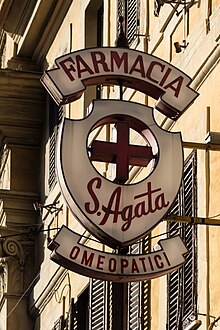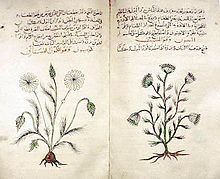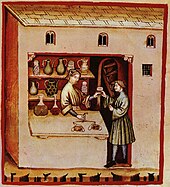History of pharmacy
[3]: 8 Prehistoric man learned pharmaceutical techniques through instinct, by watching birds and beasts, and using cool water, leaves, dirt, or mud as a soothing agent.
[3]: 21–22 The earliest known Chinese manual on materia medica is the Shennong Ben Cao Jing (The Divine Farmer's Herb-Root Classic), dating back to the first century AD.
Ranked positions in the pre-Heian Imperial court were established; and this organizational structure remained largely intact until the Meiji Restoration (1868).
[12] The advances made in the Middle East in botany and chemistry led medicine in medieval Islam substantially to develop pharmacology.
His Liber servitoris is of particular interest, as it provides the reader with recipes and explains how to prepare the "simples" from which were compounded the complex drugs then generally used.
Of great impact were also the works by al-Maridini of Baghdad and Cairo, and Ibn al-Wafid (1008–1074), both of which were printed in Latin more than fifty times, appearing as De Medicinis universalibus et particularibus by 'Mesue' the younger, and the Medicamentis Simplicibus by 'Abenguefit'.
Living in the tenth century, he wrote The Foundations of the True Properties of Remedies, amongst others describing arsenious oxide, and being acquainted with silicic acid.
For example, in 1260 CE a Cairenes pharmacist named Abu ‘I-Munā al-Kuhín al-‘Attār published a 25-chapter manual, the Minhāj al-dukkān (How to run a pharmacy), wherein he documented: titles of drugs, their ingredients and quantities, preparation methods, and dosages.
[14] It is also during the 13th and 14th centuries that Middle Eastern pharmacopoeias begin to resemble cookbooks more than medical encyclopedias, which Thomas Allsen attributes to the extensive cultural exchange between China, Iran, and the greater Mongol Empire.
[15] After the fifth century fall of the Western Roman Empire, medicinal knowledge in Europe suffered due to the loss of Greek medicinal texts and a strict adherence to tradition, although an area of Southern Italy near Salerno remained under Byzantine control and developed a hospital and medical school, which became famous by the 11th century.
[3]: 30 In the early 11th century, Salerno scholar Constantinos Africanus translated many Arabic books into Latin, driving a shift from Hippocratic medicine towards a pharmaceutical-driven approach advocated by Galen.
[3]: 30 In medieval Europe, monks typically did not speak Greek, leaving only Latin texts such as the works of Pliny available until these translations by Constantinos.
[16] Old pharmacies continue to operate in Dubrovnik, Croatia located inside the Franciscan monastery, opened in 1317[citation needed].
[17] The trend towards pharmacy specialization started to take effect in Bruges, Belgium where a new law was passed that forbid physicians to prepare medications for patients.
[7] The oldest pharmacy is claimed to be set up in 1221 in the Church of Santa Maria Novella in Florence, Italy, which now houses a perfume museum.
Florence is also the birthplace of the first official pharmacopeia, called the Nuovo Receptario, in which all pharmacies would use that document as guidance for caring for the sickly.
[4] The Royal College of Apothecaries of the City and Kingdom of Valencia was founded in 1441, considered the oldest in the world, with full administrative and legislative powers.
[22] Derivatives of phenothiazines had an important impact on various aspects of medicine, beginning with methylene blue which was originally used as a dye after its synthesis from aniline in 1876.
This inspired further work by James Collip who developed pure insulin used for human testing and dramatically changed the prospects for all diabetics.
[27] The first pharmaceutical infrastructure was the Medical Stores and Dispensary, organized by Sub-Assistant Surgeon Thomas Prendergast during Raffles' expedition to Singapore.
To support staffing shortages at the General Hospital, a proposal to select local male students from Penang Free School to become assistant apothecaries were approved.
Dr. Christopher Trebing arrived in Singapore and opened a dispensary called German Medicine Deity Medical Office.





